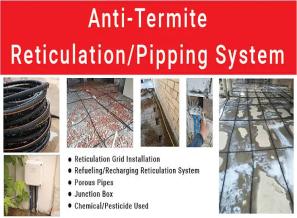How Termite Piping Works (Reticulation System):
Pipes are Laid Underground or in Flooring:
Special perforated (tiny-holed) pipes are installed around the foundation or under the slab of a building before or during construction.
They form a network that surrounds the structure — often near walls or in vulnerable areas.
Pipes Have Tiny Holes or Nozzles:
These allow even distribution of the termiticide into the soil.
The holes are spaced precisely to ensure no "blind spots" where termites...
How Termite Piping Works (Reticulation System):
Pipes are Laid Underground or in Flooring:
Special perforated (tiny-holed) pipes are installed around the foundation or under the slab of a building before or during construction.
They form a network that surrounds the structure — often near walls or in vulnerable areas.
Pipes Have Tiny Holes or Nozzles:
These allow even distribution of the termiticide into the soil.
The holes are spaced precisely to ensure no "blind spots" where termites can enter.
Chemical is Injected Through the Pipe:
The pipe is connected to a refill point (usually a small valve box) on the surface.
When treatment is needed, a pest control technician connects a chemical pump to this refill point.
Termiticide is Pumped into the System:
A high-pressure pump pushes the chemical through the pipe.
It seeps out through the holes into the surrounding soil, creating a treated barrier that kills or repels termites.
How the Chemical Comes Out:
The system uses pressure (from the pump) to force the chemical out through the tiny holes.
The soil absorbs the termiticide, forming a continuous protective zone.
Over time (typically every 3–5 years), the system can be refilled without digging up anything.
Advantages of Termite Piping:
Long-term termite control.
No need for drilling or trenching during re-treatment.
Even chemical distribution.
Safe and concealed system.
Show More















